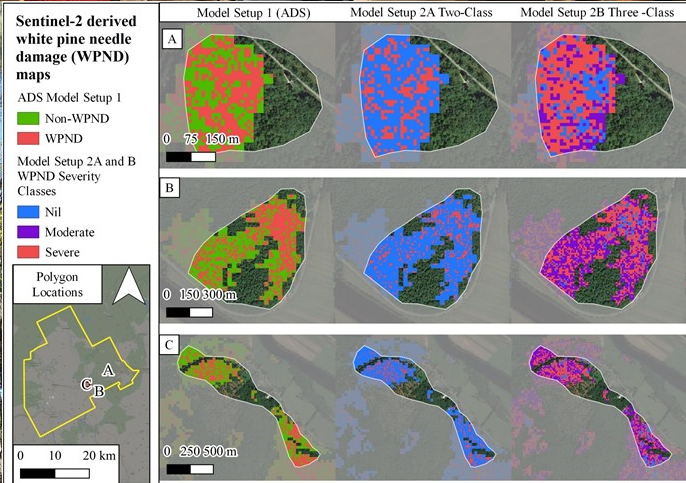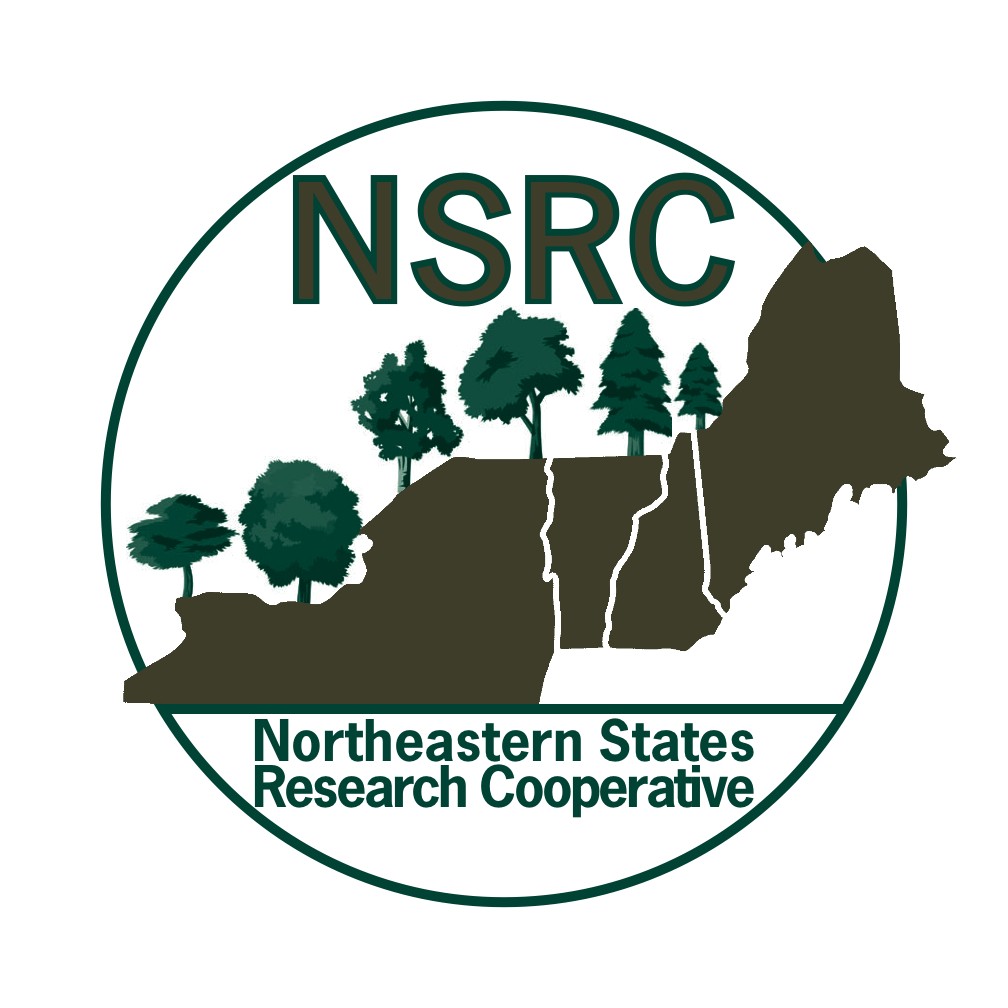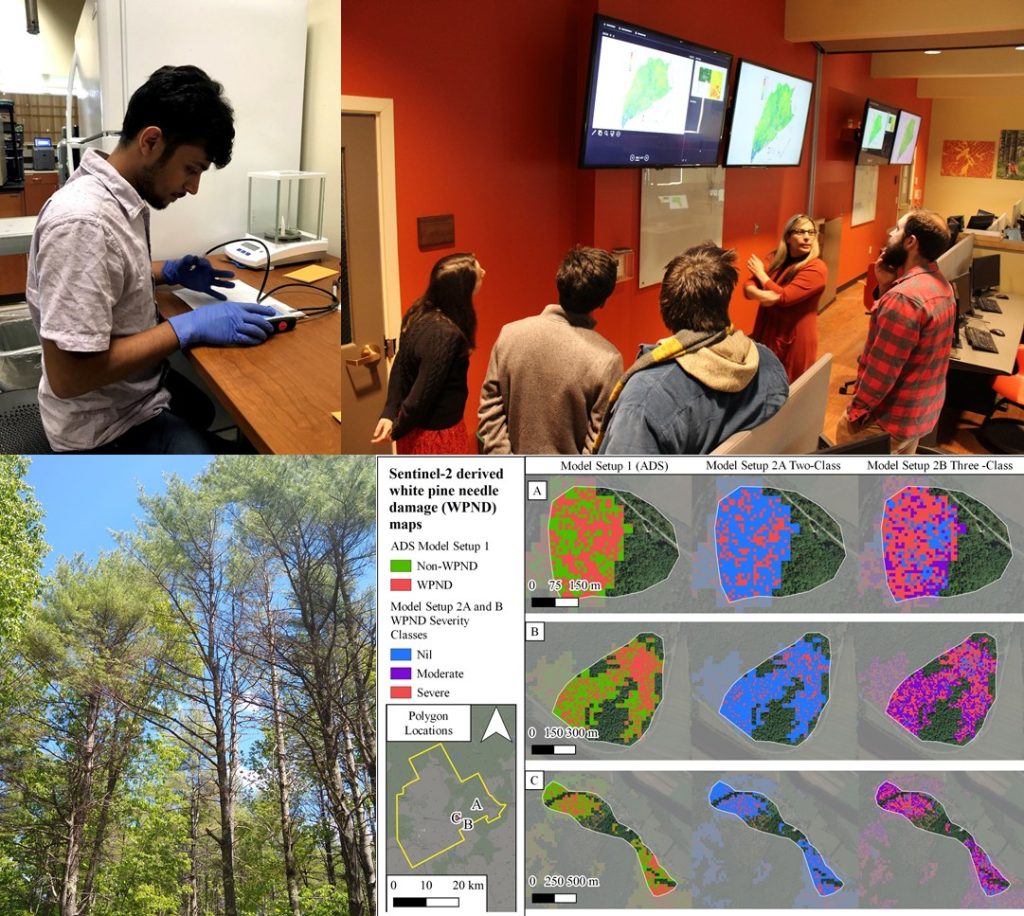
New Research Funding Will Address Health & Sustainability of Regional Forests
 NSRC Funds 12 Northern Forest Projects
NSRC Funds 12 Northern Forest Projects
Research in Maine Will Address Climate Impacts on Tree Regeneration, Eastern White Pine Health, Wetland Ecology, & Forest Habitat
Orono, ME — Northeastern States Research Cooperative (NSRC) Directors are pleased to announce 12 grants totaling nearly $2 million of federal funding and close to $1.1 million of matching funding for research that will focus on areas of concern identified by forest stakeholders in the Northern Forest region.
With strong funding support by the region’s federal delegations, collaboration with the U.S. Forest Service, and advice from the public and private sectors, NSRC prioritizes problem-driven, engaged research with solid communications to stakeholders. Partnerships between researchers and practitioners are strongly encouraged, as are projects that aim to inform and align with the timeframes of management and policy decisions.
“Research partnerships with our state institutions in the northern states have been beneficial to leveraging our collective research capabilities to address increasing risks to our forests with cutting edge science,” said Dr. Cynthia West, USFS Northern Research Station Director. “As forests face more extreme disturbances from invasive insects and pathogens, extreme weather events, as well as impacts from human activity, these partnerships are fundamental to help sustain the health and viability of the region’s forests.”
Four Maine-based projects will address a broad range of concerns related to climate impacts on tree regeneration, using remote sensing to assess Eastern White Pine health, monitoring mammal response to climate and land use change, and impacts of forestry operations on wetland ecosystems.
- Alessio Mortelliti, Associate Professor of Wildlife Habitat Conservation, UMaine Department of Wildlife, Fisheries, and Conservation Biology, aims to provide management agencies with statistically robust camera-trapping monitoring protocols that will allow them to monitor a suite of 15 mammalian species over the next decades across a large spatial scale (northern New England).
- Christina A. Murphy, USGS ME Cooperative Fisheries and Wildlife Research Unit, will study the impacts of forestry operations on wetland ecosystem, areas recognized for their important roles in supporting water quality, biodiversity, and as critical habitat for wildlife of conservation concern. By developing our understanding of these ecosystems and how they respond to harvesting, this study will inform sustainable management and prepare stakeholders for questions regarding ecological tradeoffs in management of intermittent waters throughout Northern Forest lowlands.
-

Top left: Rajeev Bhattarai (PhD student) measuring foliar biochemicals in the laboratory. Top right: Dr. Parinaz Rahimzadeh-Bajgiran (PI) and team members. Bottom left: white pine stands in Gray, Maine. Bottom right: satellite derived white pine needle damage (WPND) maps. Parinaz Rahimzadeh-Bajgiran, Assistant Professor of Remote Sensing, UMaine School of Forest Resources, will incorporate remote sensing tools using aerial and satellite imagery to assist white pine needle damage (WPND) field and aerial monitoring efforts. WPND has been the most significant threat to Eastern White Pine (an economically and ecologically important tree species in Northeastern forests) during the growing season and is expected to become more severe; this work will provide objective and spectrally explicit observations across large regions over time as part of short- and long-term efforts to monitor and mitigate negative impacts of WPND damage.
- Jay Wason, Assistant Professor of Forest Ecosystem Physiology, UMaine School of Forest Resources, is to determine how tree regeneration in the Northern Forest will respond to extreme drought, heat, and midwinter warming events to better inform forest management. Two experiments that will simulate novel future extreme climate conditions using sapling trees of 10 Northern Forest tree species will help identify forest tree species that are best and least adapted to future extreme climate events and the physiological characteristics that promote resistance and resilience to extreme climate change.
“As a PhD student in New York, being part of an NSRC project helped me to establish new collaborations and expand the impact of our project across the region,” shared awardee Jay Wason, University of Maine Assistant Professor of Forest Ecosystem Physiology. “It is very exciting now to be the lead PI on a project in the most recent round of NSRC funding. That funding is supporting our research into tree responses to extreme drought, summer heat, and winter warming as we try to understand forest regeneration in the face of extreme weather events.”
Research goals for the program, as stipulated in the 2020 NSRC Congressional Authorization, are to sponsor research to sustain the health of northern forest ecosystems and communities, develop new forest products, and to improve forest biodiversity management. NSRC also supports an Indigenous Forest Knowledge Fund (IFKF) to address structural inequities in opportunity for Indigenous youth in forest research and invest in the cultural and intellectual sovereignty of Tribal forest traditions, alongside other forms of applied forest research. NSRC recently released an RFP for the 2022 IFKF competition.
NSRC received a total of 33 research project proposals requesting $5.2 million in funding. All proposals were assessed by a team of external reviewers (researchers, practitioners, or both), with the top proposals moved forward to the Full Proposal Review Panel (FPRP) for funding prioritization. The final slate of projects selected for funding were based on the proposals themselves, the external expert reviews, the recommendations of the FPRP, and additional considerations as described in the RFP.
Media Contact: Meg Fergusson, margaret.fergusson@maine.edu, 207.581.3794
NSRC research projects, led by researchers from all four states, will begin in 2022:
Wildlife in the WUI: Investigating forest characteristics and impacts on mammalian diversity in the wildland-urban interface. Principal Investigator (PI) Daniel Bogan, Siena College
Quantifying changes in forest condition, connectivity and resilience in the northeast using geospatial and remotely sensed data. PI Melissa Clark, The Nature Conservancy
Trail forks and merges: Exploring social impacts from recreational mountain biking in northern forest communities. PI Kimberly Coleman, SUNY Plattsburgh
Implementing forest adaptation options for Northern Forest ecosystems. PI Anthony D’Amato, University of Vermont
Invasive pest effects on tree demographics across the northeastern US. PI Jeff Garnas, University of New Hampshire
Investigating the role of mycorrhizal fungi in New England forest management. PI Caitlin Hicks Pries, Dartmouth College
Jumping worm invasion and impact in the Northern Forest. PI Timothy McCay, Colgate University
Monitoring in a changing world: Developing adaptive protocols for monitoring mammals as they respond to climate and land use change in the northeastern US. PI Alessio Mortelliti, University of Maine
Effects of timber harvesting on the wetland ecology of Northeastern lowland forests. PI Christina Murphy, USGS Maine Cooperative Fish & Wildlife Unit, University of Maine
Eastern White Pine health monitoring through remote sensing assessment of foliar traits. PI Parinaz Rahimzadeh-Bajgiran, University of Maine
Oak at the edge: Investigating the importance of fire as a tool in oak range expansion. PI Matthew Vadeboncoeur, University of New Hampshire
Impacts of extreme climate events on tree regeneration in the Northern Forest. PI Jay Wason, University of Maine
###########
About the Northeastern States Research Cooperative
NSRC (https://nsrcforest.org) is a competitive grant program for Northern Forest research, authorized by Federal legislation (Public Law 105-185), with allocations to the program directed by the USDA Forest Service. Since its inception, the NSRC has funded more than 345 projects, engaging 50 different institutions, agencies, and organizations across the northeast. Federal funding comes from Congressional appropriations through a partnership with the research and development arm of the USDA Forest Service. The private sector, states, and other organizations offered matching funding to support the research on the Northern Forest and its 26 million acres in Maine, New Hampshire, New York, and Vermont.
NSRC is jointly directed through the U.S. Department of Agriculture Forest Service’s Northern Research Station and a designated institution in each of the four Northern Forest States (Rubenstein School of Environment and Natural Resources at the University of Vermont, the University of New Hampshire in cooperation with the Hubbard Brook Research Foundation in New Hampshire, the Center for Research on Sustainable Forests at the University of Maine, and the State University of New York College of Environmental Science and Forestry). These institutions are all equal opportunity providers.

